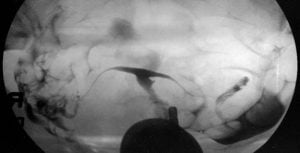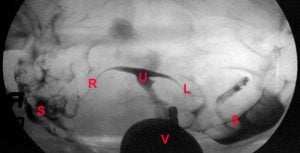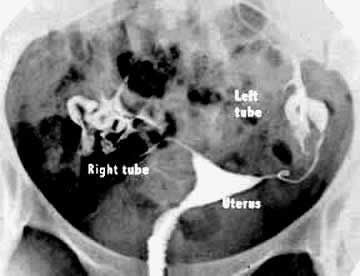
T-shaped Uterus Hysterosalpingogram Pictures
Hysterosalpingogram, HSG, shown without labels above and labeled below
A hysterosalpingogram showing a T-shaped uterus.Uterus at U ,left tube L, right tube R, dye spillage at ends of tubes on both sides at S, metal speculum in vagina at V
Normal hysterosalpingogram for comparison
A smooth triangular uterine cavity and dye spills from the ends of both tubes
A (fairly) normal uterine cavity and endometrial lining are necessary in order to conceive and maintain a pregnancy
There are several conditions related to the cavity or the lining that can cause problems. One of them is a T-shaped uterus.
This is a very rare congenital uterine malformation caused by exposure to DES, a synthetic estrogen compound (drug) that was given to some pregnant women in the 1950's and 1960's. In some cases, the DES exposure caused uterine malformations in the developing female fetus.
Sometimes these uterine malformations cause problems with a woman's ability to carry a pregnancy to full term. A T-shaped uterus increases the risk for early miscarriages, as well as the risk of preterm labor and delivery. However, some women with a T-shaped uterus carry their pregnancies without problems.
There are also other potential problems that can be caused by DES exposure, such as abnormal Pap smears - and even a predisposition to a type of cervical cancer.
Categories
About the AFCC Blog
Welcome to the Advanced Fertility Center of Chicago’s blog! Here, you will find information on the latest advancements in fertility care and treatments, including IVF, IUI, third-party reproduction, LGBTQ+ family building, preimplantation genetic testing, and more. Since 1997, we’ve used our experience and continuous investment in the latest fertility technology to help thousands of patients grow their families. Contact us today for more information or to schedule a new patient appointment.




